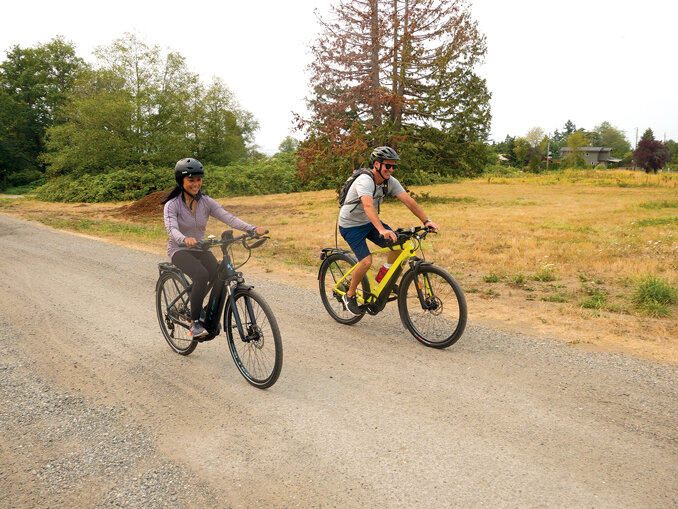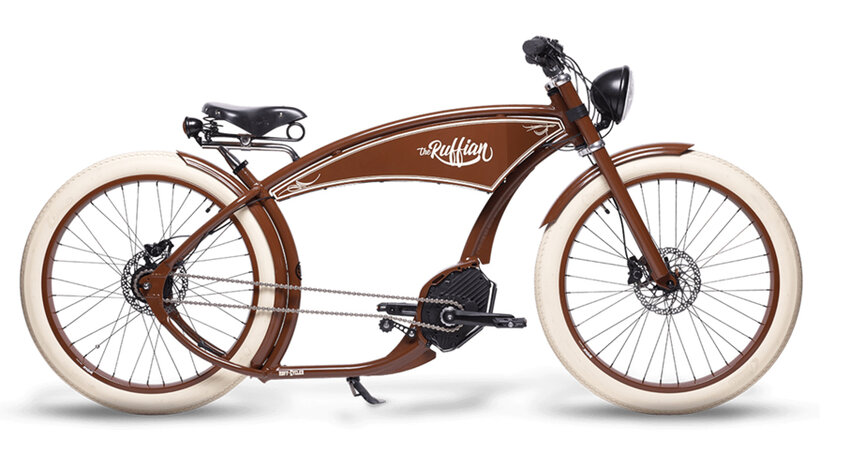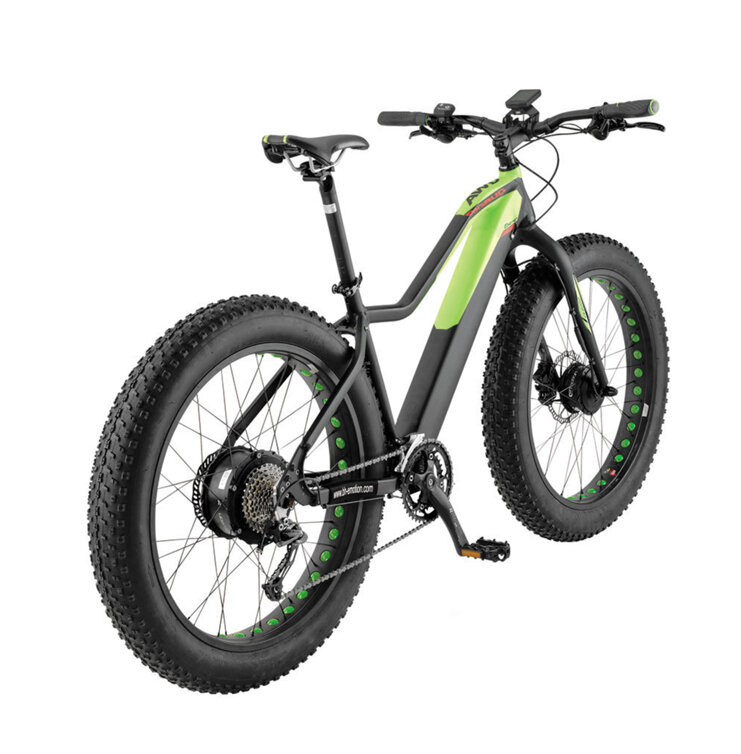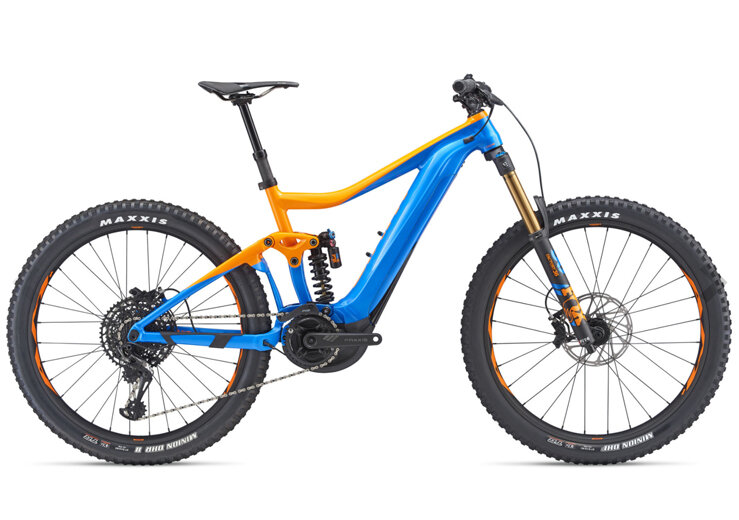
A silent revolution in the cycling world that began in China and conquered Europe is now riding strong across North America. Electric bikes, or “e-bikes” are finding fans across all ages and all styles of riding. With its quick-paced success, it might be time to hop on the bandwagon, or bike, if you will.
E-bikes offer appeal for a lot of different reasons. Millennials appreciate the technological and economical alternative to car ownership; boomers are using them to take on mountain bikers, using gravity to take them downhill and electricity to take them back up. There seems to be a version for just about anyone including pizza delivery people and green grocers making home deliveries.
Like regular bikes, e-bikes offer convenience, exercise and an excuse to get outdoors. The big difference is, you can get farther and faster with less effort if that’s what you want. Hills that would normally be viewed with trepidation can be climbed almost effortlessly depending upon your stamina and motor settings.
Leading the world in sales and usage, China has an estimated 200 million e-bikes on the road already, with another 18-30 million or so projected to be added every year by 2023. E-bike sales in Europe have been surging at double-digit rates and especially in Germany and Holland. Slow to the party but beginning to dance is the North American market.
The global information company NPD Group reports that e-bikes are showing strong year-over-year growth in the U.S., with dollar sales up 95 percent in 2017 and unit sales showing almost identical growth. The e-bike market has nearly tripled over the last three years and is showing no signs of slowing.
Who is buying these bikes? Fairhaven Bicycle Shop co-owner Matt Karre figured the market would consist of older riders wanting assistance on the hills but has found that quite a few of his customers are looking for a green alternative to a car. He recently sold a couple of Specialized e-bikes and a child trailer to a Seattle couple living in Seattle’s Queen Anne neighborhood, the highest hill in the city. Their home is on the north side, their daycare is on the south side and their offices are back on the north side. And thanks to their new electric ride, their commute is faster.
Think riding an e-bike is cheating somehow? Think again. The amount of effort you put into riding is up to you. Perhaps you don’t want to arrive at work all hot and sweaty; in that case, let the motor do more of the work and get your exercise on the way home. A big advantage to e-bikes is that it makes long commutes easier. Both time and distance are compressed when you’re riding at 20 or 28 mph instead of 10 or 12 mph.




Types of Bikes
Apart from do-it-yourself kits which are almost always hub setups, e-bikes are generally differentiated by the placement of the motor. There are hub motors which are usually placed on the rear wheel and mid-motor mounts that are connected directly to the pedal crank hub. There are pros and cons for both kinds. Hub motors are typically less expensive but they can restrict your gearing options. Replacing wheels is a bit of a pain and depending on battery placement, the handling of the bike can be different from what you would normally expect. Mid-motor mounts can take advantage of a bike’s gears; they have a lower and more central center of gravity and can be serviced easily. Germany’s Bosch and Switzerland’s Specialized have made these a popular choice.
You’ll need to decide whether you want a Class 1 pedal assist, Class 2 with throttle and pedal assist or a Class 3 S-Pedelec. Pedal assist provides motor assistance only when you’re pedaling and the amount of assistance is determined by how hard you’re pedaling and what power setting you’ve selected. Most pedal assist have eco, sport and turbo settings which give increasing assistance (and decreasing range). Bikes with throttles allow you to stop pedaling and have the motor do all of the work for you.
Regardless of the type of e-bike you’re considering, all are limited in the top speed at which the motors assist. In Canada, the motor will cease providing support at 20 mph (32 kph) while in the US the limit for Class 3 models is 28 mph (45 kph). That doesn’t mean all bikes in the States will go that fast with assistance; Class 1 or 2 models limited to the lower speed are quite common. In truth, 20 mph is plenty fast on the flats and might be a more comfortable speed for many people. Remember, going downhill your speed is only limited by wind resistance, how steep the hill is and lack of fear (or brains).
How to decide which bike to buy
You probably know the kind of bike you want already. Are you interested in a beach cruiser, an urban commuter/trekking cycle, a full-suspension mountain bike or a utility setup? Are you interested in pure recreation or is it going to be a mode of regular transportation? First, decide on your budget. You can find deals out there but you get what you pay for. The fastest-growing price band is $2000-2,500 according to global information company, The NPD Group, and the prices go up and up from there. Many bike manufacturers offer financing if you don’t have all the cash at hand. Things that will drive up the price are battery capacity, component quality, suspension features, options and motor size.
Then do your research. One place to start is at electricbikereview.com which has lots of written and video reviews of various makes, models and types of e-bikes. Other good choices are electricbike.com, cyclingweekly.com (for a European perspective) and bikeradar.com. You know the drill – Google electric bike reviews and you’ll have plenty to check out.
Next, go try out some different makes, models and types (eg. hub vs. mid-motor, urban vs. MTB). Try as many different bikes as you can – you’ll love the first one you ride but it may not be the best choice.
Depending on what features your particular bike comes with, you might have to purchase optional equipment. If you’re riding on the road or at night, good quality lights are a must. Some riders double-up on them and keep them on during the day to help drivers see them. Mirrors are also a good idea – if you’re rolling at 20 or 25 mph, swiveling your head backwards every few seconds means you’re not going to be able to avoid sudden potholes or other obstructions. Loud bells or horns that give advance warning to pedestrians should be at the top of your list. If you’re trekking or carrying cargo, racks and paniers come in all kinds and price range.
Be careful!
With increased speed comes increased risk of serious injury should a rider come off the bike or meet with a solid obstacle such as a pole or a vehicle. This is especially true for older riders. Reports from Holland show older riders are disproportionately likely to be injured or killed on an e-bike than other bikes or mopeds. E-bike users are particularly prone to head, arm and leg injuries and their injuries are twice as likely to be serious than ordinary bike users.
One thing to keep in mind is that drivers don’t necessarily perceive how fast an e-bike is going and, as a result, might think they have plenty of time to turn in front of you when they actually don’t. This means an e-bicyclist needs to ride defensively and make sure the car driver is aware of their presence. Go to whatcomsmarttrips.org for tips on defensive riding, Washington state bicycle laws, commuting and more. For an excellent overview of bike safety and laws, go to bikesense.bc.ca/bikesense-manual. Washington cyclists would benefit from reading it as well, especially if they intend to do any biking north of the border.
Don’t let your bike be stolen
Any lock can be defeated and any bike can be stolen – but you can make it difficult as possible for the thief. This means investing in a good lock and using it. Store your bike in a secure location if possible and in a lighted and well-frequented area if not. Locks come in many versions with some being barely adequate and others being too heavy to want to use on an everyday basis. U-locks are popular and reasonably effective; heavy chains with super-secure locks are even better. Asus, a German lock maker, is highly recommended by the international bike registry 529 Project which bills itself as the largest community-based bike recovery service (project529.com/garage). Most bikes that are stolen and recovered are never returned as their owners neglected to register them. Most police departments participate in Project 529 as do universities, cities, bike clubs and bike retailers. Make sure you join!
There are plenty of high-quality, independent bike retailers in the Lower Mainland and north Washington state who sell many brands of e-bikes, too many to include with their listing in the sidebar.
Get biking, e-style.
Washington
Fairhaven Bicycles
1108 11th Street
Bellingham 360/733-4433
Specialized
Jack’s Bicycle Center
1907 Iowa Street
Bellingham
360/733-1955
Giant
Skagit Cycle Center
(3 locations)
1704 S. Burlington Blvd
Burlington
360/757-7910
Blix, Raleigh, Electra, Trek, Specialized
Trek Bicycle
100 E. Chestnut Street
Bellingham
360/733-6440
Trek
Cap’s Bicycles Langley
20306 Logan Ave
Langley
604/534-7718
Norco, Specialized
Cit-E-Cycles (4 locations)
13760 104 Avenue
Surrey
604/584-7995
Bulls, Cube, gocycle, Pedego, Raleigh, Ruffian, Specialized
Pedego Electric Bikes
2774 W. 4th Avenue
Vancouver
604/620-5612
Pedego
Reckless Bike Stores
(3 locations)
110 Davie Street
Vancouver
604/648-2600
Benno, Evo, Haibike, iZip, Raleigh